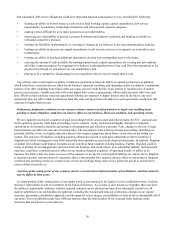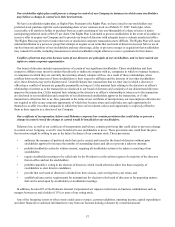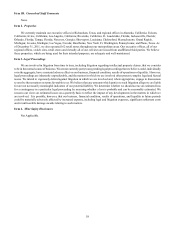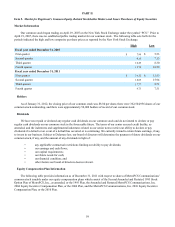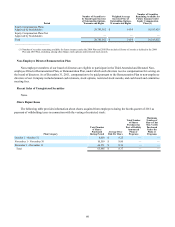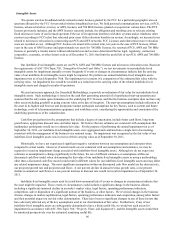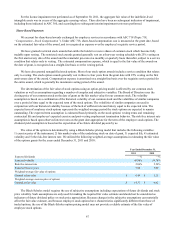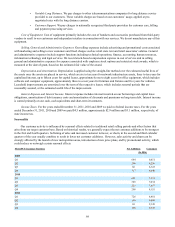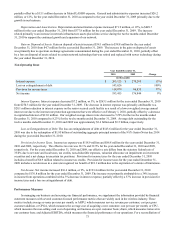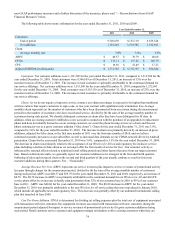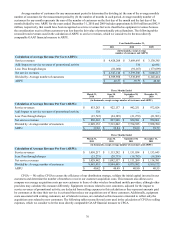Metro PCS 2011 Annual Report Download - page 77
Download and view the complete annual report
Please find page 77 of the 2011 Metro PCS annual report below. You can navigate through the pages in the report by either clicking on the pages listed below, or by using the keyword search tool below to find specific information within the annual report.66
Intangible Assets
We operate wireless broadband mobile networks under licenses granted by the FCC for a particular geographic area on
spectrum allocated by the FCC for terrestrial wireless broadband services. We hold personal communications services, or PCS,
licenses, advanced wireless services, or AWS, licenses, and 700 MHz licenses granted or acquired on various dates. The PCS
licenses previously included, and the AWS licenses currently include, the obligation and resulting costs to relocate existing
fixed microwave users of our licensed spectrum if the use of its spectrum interferes with their systems and/or reimburse other
carriers (according to FCC rules) that relocated prior users if the relocation benefits our system. Accordingly, we incurred costs
related to microwave relocation in constructing our PCS and AWS networks. FCC Licenses and related microwave relocation
costs are recorded at cost. Although FCC licenses are issued with a stated term, ten years in the case of PCS licenses, fifteen
years in the case of AWS licenses and approximately ten years for 700 MHz licenses, the renewal of PCS, AWS and 700 MHz
licenses is generally a routine matter without substantial cost and we have determined that no legal, regulatory, contractual,
competitive, economic, or other factors exist as of December 31, 2011 that limit the useful life of our PCS, AWS and 700 MHz
licenses.
Our indefinite-lived intangible assets are our PCS, AWS and 700 MHz licenses and microwave relocation costs. Based on
the requirements of ASC 350 (Topic 350, “Intangibles-Goodwill and Other”), we test investments in our indefinite-lived
intangible assets for impairment annually or more frequently if events or changes in circumstances indicate that the carrying
value of our indefinite-lived intangible assets might be impaired. We perform our annual indefinite-lived intangible assets
impairment test as of each September 30th. The impairment test consists of a comparison of the estimated fair value with the
carrying value. An impairment loss would be recorded as a reduction in the carrying value of the related indefinite-lived
intangible assets and charged to results of operations.
We used an income approach, the Greenfield Methodology, to provide an indication of fair value for our indefinite-lived
intangible assets. Such methodology is based on the cash flow generating potential of a hypothetical start-up operation and
assumes that the only assets upon formation are the underlying FCC licenses, and that the business enterprise does not have any
other assets including goodwill or going concern value at the date of inception. The start-up assumptions include utilization of
the asset in its highest and best use and incorporate market participant assumptions for key factors, such as current and future
technology, costs of telecommunications equipment, and workforce costs, considering the opportunities and constraints of the
underlying spectrum as of the valuation date.
Cash flow projections involve assumptions that include a degree of uncertainty, include future cash flows, long-term
growth rates, appropriate discount rates and other inputs. We believe that our estimates are consistent with assumptions that
marketplace participants would use to estimate fair value. For the purpose of performing the annual impairment test as of
September 30, 2011, our indefinite-lived intangible assets were aggregated and combined into a single unit of accounting,
consistent with the management of the business on a national scope. No impairment was recognized as the fair value of our
indefinite-lived intangible assets was in excess of their carrying value as of September 30, 2011.
Historically, we have not experienced significant negative variations between our assumptions and estimates when
compared to actual results. However, if actual results are not consistent with our assumptions and estimates, we may be
required to record an impairment charge associated with indefinite-lived intangible assets. Although we do not expect our
estimates or assumptions to change significantly in the future, the use of different estimates or assumptions within our
discounted cash flow model when determining the fair value of our indefinite-lived intangible assets or using a methodology
other than a discounted cash flow model could result in different values for our indefinite-lived intangible assets and may affect
any related impairment charge. The most significant assumptions within our discounted cash flow model are the discount rate,
our projected growth rate and projected cash flows. A one percent decline in annual revenue growth rates, a one percent
decline in annual net cash flows or a one percent increase in discount rate would not result in impairment as of September 30,
2011.
Indefinite-lived intangible assets must be tested between annual tests if events or changes in circumstances indicate that
the asset might be impaired. These events or circumstances could include a significant change in the business climate,
including a significant sustained decline in an entity's market value, legal factors, operating performance indicators,
competition, sale or disposition of a significant portion of the business, or other factors. We reviewed changes in the business
climate, changes in market capitalization, legal factors, operating performance indicators and competition, among other factors
and their potential impact on our fair value determination. There have been no significant changes in any of these factors that
have adversely affected any of the key assumptions used in our determination of fair value. Furthermore, if any of our
indefinite-lived intangible assets are subsequently determined to have a finite useful life, we would test such assets for
impairment in accordance with ASC 360 (Topic 360, “Property, Plant, and Equipment”), and the intangible assets would then
be amortized prospectively over the estimated remaining useful life.


